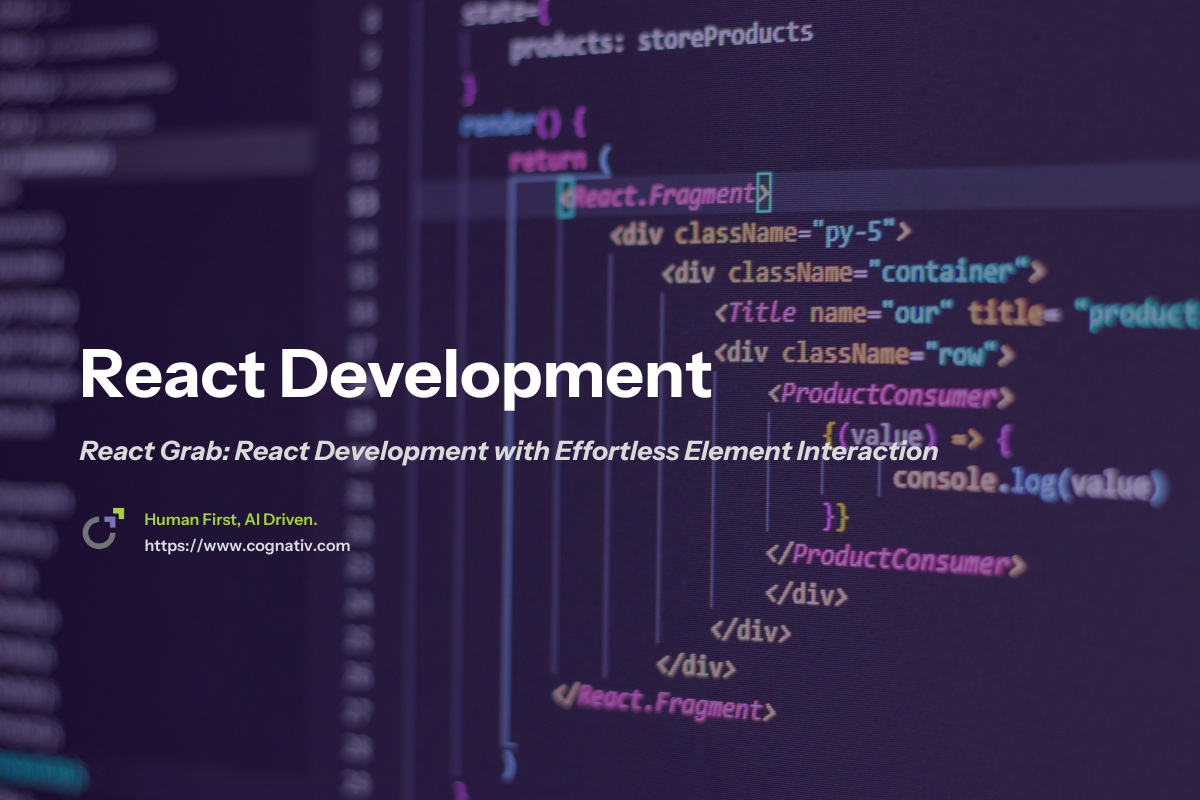

Tuesday, October 28, 2025
Kevin Anderson
React Grab: React Development with Effortless Element Interaction
In the fast-paced world of React development, finding tools that simplify workflows and enhance productivity is essential. React Grab emerges as an innovative solution that goes beyond traditional limitations by allowing developers to select and interact with elements effortlessly.
By integrating just JavaScript through a single script tag and leveraging the power of AI, this tool transforms how developers provide context, change components, and manage state within their applications.
Whether you are working within complex React frameworks, react framework environments, or simple projects, React Grab streamlines your development process with minimal setup and maximum impact.
Key Takeaways
-
Seamless Integration with React Frameworks
React Grab can be easily added to any React project, including those using the App Router, by importing the script and using the export default function RootLayout pattern. This ensures compatibility and smooth operation within modern React environments without requiring heavy build tools or configurations. -
Empowering Developers with Context and Control
By enabling developers to select elements and provide context directly to AI tools, React Grab fixes the common issue where default coding agents cannot access or modify UI components. This capability allows for dynamic changes and enhanced interaction, improving both development speed and application responsiveness. Developers can expect intuitive control over component selection and context delivery, streamlining the integration of AI-driven features. -
Flexible and Developer-Friendly Design
React Grab operates as just JavaScript, meaning it can be easily integrated without disrupting existing workflows. It supports actions such as holding keys and clicking to grab elements anonymously, and it respects environment variables like process.env to adapt behavior based on development or production modes. This flexibility makes it a practical tool for a wide range of projects and teams.

What is React Grab?
React Grab is a powerful tool designed to overcome a common limitation faced by developers: default coding agents often cannot access or modify elements within your React app. By simply using your mouse to point at and click on any element, React Grab enables you to grab that element on your page, provide it as context to AI tools like Claude Code or Cursor, and instantly make modifications. This seamless integration enhances your development workflow and boosts productivity.

Easy Installation and Setup
Installing React Grab is quick and hassle-free. You only need to add a single script tag to your application—no complicated build tools required. Whether you’re working with a plain React app or using frameworks like Next.js, React Grab fits right in.
For Next.js users with the App Router, simply import the script inside your app/layout.tsx file using the Script component during development. Once set up, hold ⌘C and click any element to grab it instantly and start modifying with ease.
For example, in a simple React app, you can add the React Grab script tag directly to your public/index.html file. After including the script, launch your app and use the ⌘C shortcut to select and edit elements on the page. This example demonstrates how easy it is to integrate React Grab into any React project.

Building Complex Interfaces with React Grab
React Grab empowers developers to build complex interfaces in React apps by making element interaction intuitive and efficient. With just a single script tag and pure JavaScript, you can unlock the ability to grab any element on your page—no matter how intricate your UI becomes. By simply holding ⌘C and clicking on an element, you instantly provide context to advanced coding agents like Claude Code, enabling them to access, analyze, and modify elements that default coding agents typically can’t reach.
This process is especially seamless when working with modern React frameworks or build tools such as Next.js. By adding the script tag and using the export default function RootLayout pattern, React Grab integrates directly into your app’s rendering flow.
The import script method ensures that setup is quick, letting you start grabbing and manipulating elements without the need for heavy configuration.
React Grab fixes the long-standing challenge of default coding agents being unable to access or modify elements within your app. Now, you can grab elements, provide rich context, and let your tools generate or update code dynamically.
Whether you’re building a dashboard, a data-driven page, or a highly interactive component, React Grab streamlines the process—making it easy for users to start, hold, click, and grab elements as needed. This tool is designed to help you move from idea to implementation faster, all while maintaining full control over your app’s elements and context.

Enhancing Navigation and Element Access
React Grab works seamlessly with React’s App Router, allowing you to create a smooth and interactive navigation experience. Compatible with popular tools such as Cursor, Claude Code, and OpenCode, it empowers developers to access, grab, and modify elements dynamically. React Grab also supports grabbing and interacting with children elements within complex UI components, enabling flexible and precise control over nested structures.
By fixing the inability of default coding agents to access elements, React Grab ensures you have full control over your app’s UI components, making your React applications more interactive and responsive.

Customization Options for Tailored Experiences
React Grab isn’t just about grabbing elements—it’s about giving developers the flexibility to create truly tailored experiences. With seamless integration into your app router, you can add the script tag directly inside your layout, ensuring React Grab works across your entire React app. The build tool support means you can install React Grab with a single command, making the process of getting started as smooth as possible.
Customization is at the heart of React Grab. You can set the cursor type and color to match your project’s style, making the grabbing experience both intuitive and visually consistent. The provide context feature allows you to supply additional information to coding agents, enabling smarter, more accurate code changes and element manipulation. This is especially useful when working with complex interfaces where context is key to making precise updates.
The idea behind React Grab is to simplify the process of grabbing, selecting, and changing elements—without the need to manually write boilerplate code. Its matrix of features, from global applicability to DOM manipulation, means you can use React Grab in any project, regardless of the framework or build tool. The repository is actively maintained, with ongoing development focused on adding new features and improving usability.
React Grab’s null and anonymous features make it accessible even for developers new to React, while advanced users can leverage state management, sharing, and dynamic changes to build sophisticated interfaces. You can add, set, and return grabbed elements, manage their state, and share context across your app. The action of clicking and holding to grab elements is designed to be as straightforward as possible, so you can focus on building, not configuring.
Whether you’re starting a new project or adding to an existing one, React Grab’s customization options ensure you can create interfaces that are as unique as your users’ needs. With support for different environments via env variables, and the ability to add or change features as your project evolves, React Grab is the tool that adapts to your workflow—making complex interface development in React truly effortless.

Troubleshooting and Community Engagement
If you encounter any issues, React Grab offers extensive resources including an issue tracker and a supportive Discord community. You can report bugs, share ideas, and receive assistance from fellow developers.
As an open-source project licensed under MIT, React Grab encourages contributions. Follow the Contributing Guide to join the community and help improve this innovative tool.

Advanced Features and Best Practices
Beyond basic element grabbing, React Grab supports advanced use cases like building interactive projects—such as gradient generators that capture an element’s style and render it dynamically on the DOM. React Grab also attaches properties like 'created' to elements, ensuring compatibility with both React DOM elements and custom components.
To get the most out of React Grab, always provide clear context when modifying elements and integrate it with other React frameworks and libraries. For best practices, you can set properties such as 'disabled={true}' to make a component static or fully controlled, preventing dragging when needed. This ensures your app stays scalable, maintainable, and highly interactive.

Elevate Your React Projects Today
React Grab is a must-have tool for React developers seeking to enhance their apps’ interactivity with minimal effort. By enabling easy element grabbing, context provision, and AI-powered modifications, it transforms how you build and maintain React applications.
Start leveraging React Grab now, join the growing community, and unlock new possibilities in React development. Share your projects, contribute to the tool, and experience a smarter way to interact with your React elements.

